Fibrolamellar Carcinoma
Images
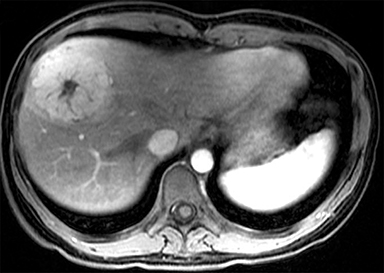
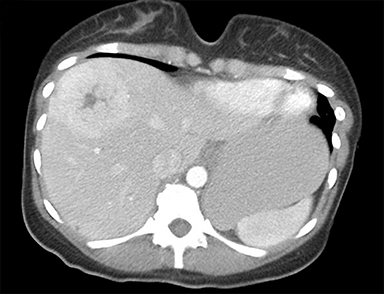
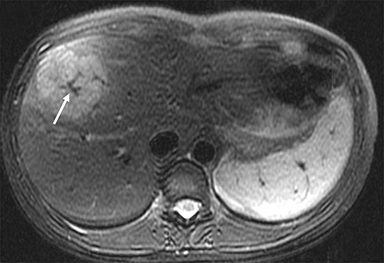
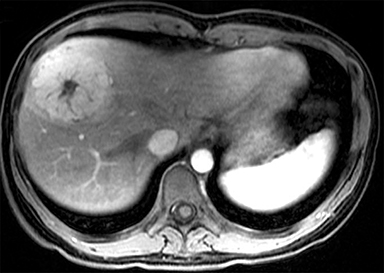
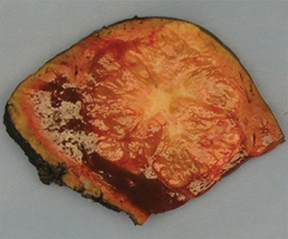
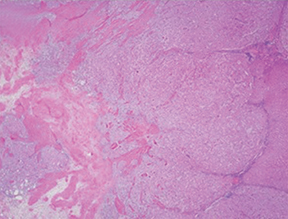

CASE SUMMARY
A 24-year-old presented with left flank pain and urinary symptoms. Unenhanced abdominal CT, performed to exclude nephrolithiasis, revealed an isoattenuating liver lesion with calcifications.
The patient had no previous history of chronic liver disease or alcohol ingestion and the physical examination was unremarkable. Hepatic enzymes were elevated (ALT:1295, AST:1050). Laboratory tests for hepatitis were negative. MRI findings were concerning for fibrolamellar hepatocellular carcinoma (FLC). A CT-guided liver biopsy, followed by surgical resection, confirmed the diagnosis of FLC.
IMAGING FINDINGS
On the unenhanced CT, a few foci of calcification were seen within the scar of the lesion. A CECT obtained for preoperative staging demonstrated a hypervascular liver mass in segment VIII measuring 7 x 6 cm with a nonenhancing central scar (Figure 1). Liver MRI showed a well-defined, lobulated hepatic mass, isointense on T1 images, hyperintense with a hypointense central scar on T2 images, and arterial phase hyperenhancement with a hypoenhancing scar (Figure 2). Pathological analysis of the lesion was performed after resection (Figure 3).
DIAGNOSIS
Fibrolamellar hepatocellular carcinoma (FLC).
Focal Nodular Hyperplasia (FNH) was raised as a diagnostic consideration during review at multidisciplinary tumor board, leading to surgical biopsy before resection.
DISCUSSION
Fibrolamellar hepatocellular carcinoma is an uncommon variant of hepatocellular carcinoma (HCC), with distinct clinical and pathological features and accounting for 1 to 9% of all HCC. Unlike HCC they are not associated with cirrhosis, alcoholism, or hepatitis B/C infection. This tumor occurs more frequently in younger patients (10-31 years of age). Alpha-fetoprotein (AFP) levels are typically normal.1
On pathological analysis FLC is characterized by large tumor cells with eosinophilic cytoplasm due to abundant mitochondria and prominent nuclei arranged in cords surrounded by lamellated collagen fibers.1
Patients with FLC may be asymptomatic or present with weight loss, fatigue, and/or abdominal pain. At diagnosis more than 80% of tumors present as a large (5 to 20 cm in diameter), well-defined, solid mass with lobulated contours and a central stellate scar. On unenhanced images, small foci of calcifications are seen in 35–68% of cases. After contrast administration, these tumors demonstrate heterogeneous enhancement in the arterial and portal venous phases, with increasing homogeneity on delayed images.2 The scar is usually non-enhancing and is best visualized on delayed images.
On MRI, FLC appears nearly isointense on T1 images and hyperintense on T2 images, relative to liver parenchyma. The central scar is typically hypointense both on T1 and T2 images. The low signal intensity on T2 imaging and the presence of calcifications distinguish FLC from FNH central scars. After contrast administration, the enhancement pattern is similar to that seen on CT. FLC does not retain hepatobiliary-specific contrast agents, another distinguishing characteristic from FNH. FLC shows restricted diffusion on diffusion-weighted imaging.
Differential diagnoses include FNH, cavernous hemangioma, and hepatocellular carcinoma.3
Nodal metastases occur in up to 65% of cases, and distant metastases occur in 20–30% of FLC; common sites are the lungs, peritoneum, and adrenal glands.4 Resection is the treatment of choice, with a resulting 5-year survival of 76% compared to 37-56% survival for conventional HCC.5 Recurrence is frequently seen in patients with FLC; thus, post-operative follow-up imaging studies remain important.1
CONCLUSION
Fibrolamellar hepatocellular carcinoma is a malignant hepatocellular tumor with demographic, pathological, and clinical characteristics distinct from those of HCC. Knowledge of specific radiological findings on CECT and MRI is important for diagnosing this rare tumor and distinguishing it from the much more common incidental FNH.
REFERENCES
- McLarney JK, Rucker PT, Bender GN, Goodman ZD, Kashitani N, Ros PR. Fibrolamellar carcinoma of the liver: radiologic-pathologic correlation. Radiographics. 1999;19: 453-471.
- Ichikawa T, Federle MP, Grazioli L, Madariaga J, Nalesnik M, Marsh W. Fibrolamellar hepatocellular carcinoma: imaging and pathologic findings. Radiology. 1999;213:352-361.
- Smith MT, Blatt ER, Jedlicka P, Strain JD, Fenton LZ. Best cases from the AFIP: fibrolamellar hepatocellular carcinoma. Radiographics. 2008;28:609-613.
- Chaudhari VA, Khobragade K, Bhandare M, Shrikhande SV. Management of fibrolamellar hepatocellular carcinoma. Chinese Clinical Oncology. 2018;7:51.
- Kassahun WT. Contemporary management of fibrolamellar hepatocellular carcinoma: diagnosis, treatment, outcome, prognostic factors, and recent developments. World J Surg Oncol. 2016;14:151.
Citation
LA E, J K, S G, O B, KK.Fibrolamellar Carcinoma. Appl Radiol. 2021; (2):46-47.
March 11, 2021